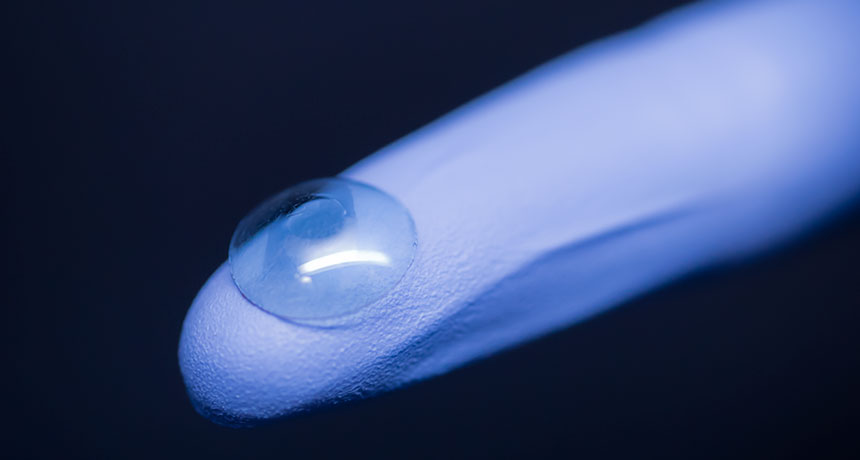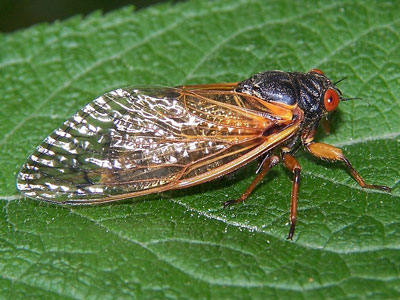Plastic that mimics insect wings kills bacteria
The curved plastic may one day be used as an artificial cornea

Tiny pillars on insect wings inspired scientists and engineers to make polymer nanopillars that can kill bacterial cells on this artificial cornea.
Jonathan Pegan
Share this:
- Share via email (Opens in new window) Email
- Click to share on Facebook (Opens in new window) Facebook
- Click to share on X (Opens in new window) X
- Click to share on Pinterest (Opens in new window) Pinterest
- Click to share on Reddit (Opens in new window) Reddit
- Share to Google Classroom (Opens in new window) Google Classroom
- Click to print (Opens in new window) Print
A new plastic that mimics the surface of insect wings might help save people’s eyesight. More than 40,000 people each year need a transplant for the front part of the eye, called the cornea. But donors aren’t always available. Also, some people’s bodies won’t accept a replacement from someone else. And bacteria could easily infect materials for artificial ones — at least until now.
Researchers at the University of California (UC), Irvine have made an antibacterial material with thousands of teeny, spike-like pillars. Each pillar is like one of the invisible hairs on a cicada wing. And like the insect wings, the surface kills various types of bacterial cells. Better still, such surfaces can be shaped in a curve, just like the eye is.

Yee learned about medical researchers wanting to mimic the surfaces of wings on cicadas and dragonflies. Bacteria die after landing on those surfaces. The microbes jab themselves into the nanospikes on those wings. Essentially, they spear themselves to death.
Yee and his colleagues decided to see if ideas from the earlier work might help keep plastic corneas similarly germ-free. His group chose a plastic called PMMA. It’s short for polymethylmethacrylate (POL-ee-METH-ul-meh-THAK-rih-LATE). They used a readily available mold to make it into spikey nanopillars. The flat mold had thousands of tiny indentations. Heated PMMA was pressed against the mold. Later, the cooled PMMA came out bearing nanospikes like those on cicada wings. In tests, this surface killed lots of thin-walled bacteria, such as E. coli.
But a cornea is curved, not flat. And just as a paper wrinkles as you press it around a baseball, flat polymers get distorted around curved shapes. To deal with that, the group made a new curved mold. Cooled PMMA comes out of this mold already curved.
 “We’ve done initial testing to prove that it will work for the cornea device,” says Mary Nora Dickson. This chemical engineer is a graduate student at UC Irvine and a member of the research team. She and fellow graduate student Elena Liang reported on their team’s work on March 16 in San Diego at the spring meeting of the American Chemical Society.
“We’ve done initial testing to prove that it will work for the cornea device,” says Mary Nora Dickson. This chemical engineer is a graduate student at UC Irvine and a member of the research team. She and fellow graduate student Elena Liang reported on their team’s work on March 16 in San Diego at the spring meeting of the American Chemical Society.
The next challenge
The researchers now hope to tweak their material so that it will kill bacteria with cell walls thicker than E. coli. This would fight infections such as staph (caused by Staphylococcus germs). The trick requires building taller nanospikes, like those on dragonfly wings. But, notes Dickson, “It’s actually pretty difficult to make polymers into skinny shapes without damaging them.”
As molecules go, polymer chains are “kind of like spaghetti,” she explains. “It might be easy to put spaghetti into a big bowl. If you tried to put it into something skinny, like a vase, it will get harder and harder to push that spaghetti into that skinny shape.” Getting the material out of the mold also gets harder as the pillars grow taller.
Her team is now applying coatings to the molds for the plastic to see if that helps. A light spray of oil makes it easier to get cupcakes out of a tin. The group hopes its coatings might do the same thing for the nanospikes on their plastic.
This new research adds to other studies probing how to tweak the form and structure of materials at the smallest scales. Taken together, they show “you can profoundly affect the way cells interact with a given surface,” says Masaru Rao. He’s a materials engineer at the University of California, Riverside. That principle could work for other medical uses as well, he suspects.
Also, the ability to kill bacteria comes from the material’s structure. In contrast, most other antibacterial materials have a coating. So, Rao says, this new approach “may yield greater reliability and damage-resistance.” The process for making the nanospike-shaped plastic also can be scaled up. So low-cost production of medical devices might be possible.
Before that happens, additional tests must take place. The team needs more proof of the material’s germ-killing abilities, of how long the material can do its job, and if there are any side effects.
Meanwhile, Rao observes, “There’s still much we can learn from nature.”
Power Words
antibacterial Having properties that tend to destroy or limit the growth or reproduction of bacteria.
antibiotic A germ-killing substance, usually prescribed as a medicine (or sometimes as a feed additive to promote the growth of livestock). It does not work against viruses.
bacterium (plural bacteria) A single-celled organism. These dwell nearly everywhere on Earth, from the bottom of the sea to inside animals.
cell The smallest structural and functional unit of an organism. Typically too small to see with the naked eye, it consists of watery fluid surrounded by a membrane or wall. Animals are made of anywhere from thousands to trillions of cells, depending on their size.
chemical engineer A researcher who uses chemistry to solve problems related to the production of food, fuel, medicines and many other products.
cornea The transparent front section of the eye. The shape of the cornea allows our eyes bring objects at many distances into focus.
E. coli (short for Escherichia coli) A bacterium that researchers often use to study genetics. Some types of this microbe cause disease, but many other forms of it do not.
engineer A person who uses science to solve problems. As a verb, to engineer means to design a device, material or process that will solve some problem or unmet need.
germ Any one-celled microorganism, such as a bacterium, fungal species or virus particle. Some germs cause disease. Others can promote the health of higher-order organisms, including birds and mammals. The health effects of most germs, however, remain unknown.
graduate student Someone working toward an advanced degree by taking classes and performing research. This work is done after the student has already graduated from college (usually with a four-year degree).
materials engineering The design of the new substances, focusing on how their atomic and molecular structure affects their overall properties. Materials engineers can create new materials or gain important insights by probing existing ones. Their analyses of a material’s overall properties (such as density, strength and melting point) can lead to the creation of novel materials that are tailor-made for some new use.
molecule An electrically neutral group of atoms that represents the smallest possible amount of a chemical compound. Molecules can be made of single types of atoms or of different types. For example, the oxygen in the air is made of two oxygen atoms (O2), but water is made of two hydrogen atoms and one oxygen atom (H2O).
nano– A prefix indicating a billionth. In the metric system of measurements, it’s often used as an abbreviation to refer to objects that are a billionth of a meter long or in diameter.
nanotechnology Science, technology and engineering that deals with things and phenomena at the scale of 100 billionths of a meter or less.
plastic Any of a series of materials that are easily deformable; or synthetic materials that have been made from polymers (long strings of some building-block molecule) that tend to be lightweight, inexpensive and resistant to degradation.
polymer Substances whose molecules are made of long chains of repeating groups of atoms. Manufactured polymers include nylon, polyvinyl chloride (better known as PVC) and many types of plastics. Natural polymers include rubber, silk and cellulose (found in plants and used to make paper, for example).
Staphylococcus aureus (also known as staph) A species of bacteria that is responsible for a number of serious human infections. It can cause surface abscesses, or boils. If it gets into the bloodstream, where it can be carried throughout the body, it may also cause pneumonia and infections of the joints or bones.
transplant (in medicine) The replacement of a tissue or an organ with that from another organism. It is also a term for the material that will be transplanted.
technology The application of scientific knowledge for practical purposes, especially in industry — or the devices, processes and systems that result from those efforts.
This is one in a series presenting news on technology and innovation, made possible with generous support from the Lemelson Foundation.







